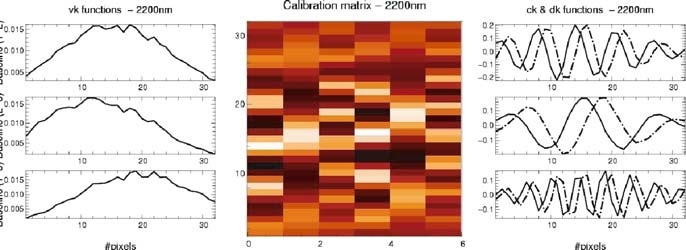|
|
 |
| |
| QC PLOTS |
| |
CURRENT |
HISTORY |
| P2VM |
 |
 |
| QC1 database (advanced users):
browse
|
plot
|
Click on CURRENT to see the current trending (Health Check).
Click on HISTORY to see the historical evolution of the trending. |
For AMBER as for every other interferometer it is important to separate the astrophysical and the instrumental parts. The instrumental part is characterized by the so-called
Pixel To Visibility Matrix.
This calibration procedure is performed with an internal source located in the Calibration and Alignment Unit (CAU).
The daily calibrations are done for instrumental trending on a selected set of P2VM (Low Resolution JHK, Low resolution K, Medium Resolution K, High Resolution K 1.979 to K 2.481). These modes are the main AMBER modes.
During the observing night, for each mode (Low, Medium and High resolutions, J, H, K bands, 2 or 3 telescopes), the P2VM should be measured within a few hours of the scientific observation in order to get an accurate calibration. This P2VM must be repeated each time the instrument setting (dispersive element for example) is changed.
Since september 2009, some raw fits files recorded for the P2VM contain all frames but one filled with zeros. Although, the ESO pipeline reduces these data, the problem is under investigation in Paranal.
The P2VM consists of a sequence of high Signal to Noise ratio calibration files taken in succesive configurations (see table where X means shutter closed, and O means open shutter).
sequence of files for the P2VM (in the 3 telescopes case)
| Step |
Sh1 |
Sh2 |
Sh3 |
Phase |
telescopes |
| 1 |
X |
X |
X |
No |
|
| 2 |
O |
X |
X |
No |
1 |
| 3 |
X |
O |
X |
No |
2 |
| 4 |
O |
O |
X |
No |
1,2 |
| 5 |
O |
O |
X |
Yes |
1,2 |
| 6 |
X |
X |
O |
No |
3 |
| 7 |
O |
X |
O |
No |
1,3 |
| 8 |
O |
X |
O |
Yes |
1,3 |
| 9 |
X |
O |
O |
No |
2,3 |
| 10 |
X |
O |
O |
Yes |
2,3 |
The image resulting from the step 3 (two shutters open) is shown bellow for the Low resolution JHK in a 2 telescopes case, and the medium resolution K in a 3 telescopes case.
For the Low resolution, 2 telescopes we see from left to right the dark channel, the Photometric channel 1, the interferometric channel, the photometric channel 2. The wavelength is represented on the y axis, the J H K bands are seen. In the interferometric channels, the difference in the Visibility and frequency of the fringes can be seen between the J H and K band.
For the Medium Resolution image, we see from left to right, the dark channel, the P1 channel, the P2 channel (without signal), the interferometric channel, the P3 channel.
From the steps 1, 2 and 5: estimation of the flux ratio vi,k
For each telescope beam, an image is recorded with only this shutter
opened. The fraction of flux measured between the interferometric channel
and the illuminated photometric channel is estimated (these are called vik
functions (see Figure bellow, left)).
From the other steps: characterization of the other quantities
In order to compute the instrumental quantities used to calibrate (carrying waves cij,k and dij,k), one needs to have two independent
(in terms of algebra) measurements of the interferogram, since there
are two unknowns (per baseline) to compute. The principle is the following:
two shutters are opened simultaneously and for each pair of beams,
then the interferogram is recorded on the detector. Such an interferogram
corrected for its DC component and calibrated by the photometry, yields
the carrying waves cij,k.To obtain its quadratic counterpart, the previous procedure is repeated by introducing a known phase shift close to 90 degree, using piezoelectric mirrors at the entrance of beams 2 and 3. It is then possible to calculate the carrying waves dij, k. The figure bellow shows on the middle and right 2 representations of the carrying waves.
 |
During the P2VM recipe, the pipeline also calculates the offset between the different photometric channels (P1, P2, P3) and the interferometric channel.
With the P2VM templates it is also possible to take wavelength calibration files. If these files are present, the wavelength calibration is extracted from them which leads to a more accurate P2VM. If these files are not present, the pipeline will use a static wavelength calibration file.
QC1 parameters
The P2VM is a calibration file used to calibrate the interferometric data. It is also used for instrument trending. For this purpose, the pipeline calculates a set of QC1 parameters to monitor the instrument.
These parameters are the offsets in pixels for the different photometric channels and the internal Visibility of the instrument. The offset is measured in the spectral direction between the different photometric channels and the interferometric channel.
For the 2 telescopes case: calculated_P1/2_offset, measured_P1/2_offset, int_Vis_base12 and its associated error err_int_Vis_base12, int_Vis_J/H/K_base12, err_int_Vis_J/H/K_base12......
For the 3 telescopes case the additionnal parameters are calculated: calculated_P3_offset, measured_P3_offset, int_Vis_base23, int_Vis_base31 ...
Trending
History
Each time there is a re-alignment or an intervention on the instrument, the offset and the internal Visibility are changing. |
![[ ESO ]](/images/eso-logo.gif)
![[ ESO ]](/images/eso-logo.gif)
